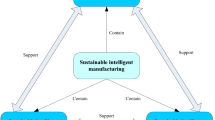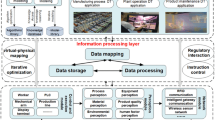Abstract
In manufacturing practice for each machining operation, transfer techniques are extensively used for the allocation of manufacturing specification tolerance type and value. This paper focuses more on tolerance type which is the basis for a coherent and complete tolerancing process. We developed an algorithmic method called “DISMP” in order to generate the necessary types of manufacturing specifications that guarantee the respect of the functional requirements. A geometric variation model, based on the invariants degrees of freedom (DOFs) of the datum reference frames (DRF) and the toleranced surfaces serves to specify the two extremities of the tolerance chain. The identification of the controlled DOFs (Cont-DOFs) of the positioning reference frames in each machining phases and also the constrained DOFs (Cons-DOFs) of each machined surface contributes to the development of the way linking between the functional toleranced surface and its functional DRF. To generate the appropriate manufacturing geometric specifications, our method can be divided in five steps. We started by the translation of the ISO functional specification using the topologically and technologically related surfaces rules “TTRS” (Step 1: M1). Mapping the manufacturing process (Step 2: M2 and M3) requires the identification of the Cons-DOFs of the machined surfaces and those controlled by the positioning surfaces “Cont-DOFs” in each phase. The search of all chain links, which constitute the tolerance chain, is realized on Step3 (M4 and M5). Then, in step 4 (M6), we generate ISO standardized manufacturing specification. The fifth step (M7) draft technological constraints related to the manufacturing process, i.e., the case where there are inversion in the order between the toleranced surfaces and its DRF. Finally, we present the manufacturing process phases with ISO standards requirements.
Similar content being viewed by others
References
Weill R (1988) Integrating dimensioning and tolerancing in computer- aided process planning. Robot Comput-Integr Manuf 4(1/2):41–48. doi:10.1016/0736-5845(88)90058-0
Anselmetti B, Bourdet P (1993) Optimisation of a work piece considering production requirements. Comput Ind 21:23–34. doi:10.1016/0166-3615(93)90042-Y
Anselmetti B (2003) Cotation de fabrication et métrologie. Edition PYC, Paris
Bourdet P, Ballot E (1995) Geometrical behavior laws for computer aided tolerancing, 4th CIRP Seminar on Computer Aided Tolerancing, University of Tokyo April 95
Thibaut F (2001) Contribution à la définition d’un moyen unifié de gestion de la géométrie réaliste base sur le calcul des lois de comportement des mécanismes. Thèse présentée à l’école normale supérieure de Cachan
Tichadou S (2005) Modélisation et quantification tridimensionnelles des écarts de fabrication pour la simulation d’usinage. Thèse présentée à L’Ecole Centrale de Nantes
Tichadou S, Legoff O, Hascoet JY (2005) 3D GEOMETRICAL MANUFACTURING SIMULATION Compared approaches between integrated CAD/CAM systems and small displacement torsor models, Advances in Integrated Design and Manufacturing in Mechanical Engineering. Springer, Dordrecht, pp 201–214
Vignat F (2005) Contribution à l'élaboration d'un modèle 3D de simulation de fabrication pour l'analyse et la synthèse des tolérances, le modèle MMP, thèse présentée a institut national polytechnique de grenoble
Vignat F, Villeneuve F (2007) A numerical approach for 3D manufacturing tolerances synthesis. 10th CIRP Conference on Computer Aided Tolerancing Specification and Verification for Assemblies March 21st–23rd, 2007 in Erlangen, Germany
Le pivert P (1998) Contribution à la modélisation et à la simulation réaliste des processus d’usinage. Thèse présentée à l’école centrale paris
Ayadi B, Anselmetti B, Bouaziz Z, Zghal A (2007) Three-dimensional modelling of manufacturing tolerancing using the ascendant approach. Int J Adv Manuf Technol 39:279–290. doi:10.1007/s00170-007-1225-3
NF ISO 1101 Fevrier (2005) Spécification géométrique des produits (GPS) Tolérancement géométrique, Tolérancement de forme, orientation, position et battement
ASME Y14 5.1M-1994 (1994) Mathematical definition of dimensioning and tolerancing principles. The American Society of Mechanical Engineers, New York
ASME Y14 5.M-1994 (1994) Dimensioning and tolerancing. The American Society of Mechanical Engineers, New York
Clément A, Rivière A, Temmerman M (1994) Cotation tridimensionnelle des systèmes mécaniques. PYC Edition, Paris
Gaunet D (1994) Model formel de tolérancement de position, Contribution a l’aide au tolérancement des mécanismes en CFAO. Thèse présentée à l’école normale supérieure de cachan
Desrochers A. Modèle conceptuel du dimensionnement et du tolérancement des mécanismes. Présentation dans les systèmes CFAO. Thèse soutenue le 24 septembre 1991 à l’école centrale Paris
Rivière A (1993) La géométrie du groupe des déplacements appliquée à la modélisation du tolérancement. thèse soutenue à l’école centrale Paris
Kumaravel P, Anand S, Ullas U, Mohanram PV (2007) Cost optimization of process tolerance allocation-a tree based approach. Int J Adv Manuf Technol 34:703–713. doi:10.1007/s00170-006-0641-0
Bellacicco A, Sellakh R, Arotcarena P, Rivière A (2005) Méthode Rationnelle de Tolérablement 3D du process, 9th CIRP Seminar on Computer Aided Tolerancing, Phoenix (Arizona USA)
Jaballi K, Bellacicco A, Louati J, Rivière A, Haddar M (2007) A computer aided tolerancing: algorithm for 3d manufacturing tolerancing. Advances in Production Engineering & Management 2(4):163–176
Anselmetti B (2006) Generation of functional tolerancing based on positioning features. Comput Aided Des 38:902–919. doi:10.1016/j.cad.2006.05.005
Author information
Authors and Affiliations
Corresponding author
Rights and permissions
About this article
Cite this article
Jaballi, K., Bellacicco, A., Louati, J. et al. Dimensioning of the intermediate states of the machined phases “DISMP” approach. Int J Adv Manuf Technol 45, 907–921 (2009). https://doi.org/10.1007/s00170-009-2040-9
Received:
Accepted:
Published:
Issue Date:
DOI: https://doi.org/10.1007/s00170-009-2040-9




